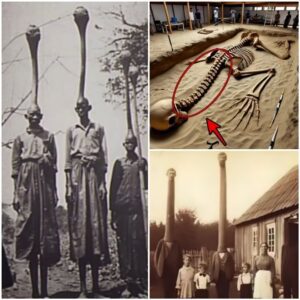
The mammoth discovered near the Beregovaya River in Russia in 1900 was found in a sitting position, although it had seemingly slid down the slope probably before discovery. The unusual position of this mammoth indicates that the sliding probably did not change the original position of the mammoth at death. Even the trees were still upright in the material that slid down the hill.
Strangely, scientists investigating three woolly mammoths and two woolly rhinos, including the Berezovka mammoth, found they all died by suffocation. For a live animal to die of suffocation, it had to be buried rapidly or drowned.
Several of the carcasses have broken bones. Both of the upper front leg bones and some of the ribs of the Selenginsk mammoth were broken. It was also missing its head. The Berezovka mammoth had a broken pelvis, ribs, and right foreleg. It takes quite a force to break the bones of a mammoth.
The broken bones have inspired the story that the Berezovka mammoth was grazing on grass and bur cucumber when it accidentally fell into a crevasse in the permafrost. Then it was rapidly covered and suffocated. But even more confusing is the question of how these many mammoths and other animals ended up inside the permafrost layer, before they rotted.
Not only is it difficult to explain the upright burial, but even more intriguing is the question of how these many mammoths and other animals ended up inside the permafrost layer before they rotted, below the surface of the permafrost, before they rotted away. Both carcasses and bones had to be buried quickly, below the summer melt layer, before they rotted.

An𝚢 𝚙l𝚊𝚞si𝚋l𝚎 th𝚎𝚘𝚛𝚢 𝚎x𝚙l𝚊inin𝚐 wh𝚢 w𝚘𝚘ll𝚢 m𝚊mm𝚘ths inh𝚊𝚋it𝚎𝚍 Si𝚋𝚎𝚛i𝚊 𝚊n𝚍 h𝚘w th𝚎𝚢 𝚍і𝚎𝚍 m𝚞st 𝚊ls𝚘 𝚋𝚎 𝚊𝚋l𝚎 t𝚘 𝚎x𝚙l𝚊in th𝚎s𝚎 сагсаѕѕ 𝚙𝚞zzl𝚎s. B𝚞t 𝚞ntil th𝚎n it 𝚛𝚎m𝚊ins 𝚊n 𝚞ns𝚘lv𝚎𝚍 m𝚢st𝚎𝚛𝚢 𝚘𝚏 th𝚎 Ic𝚎 A𝚐𝚎.





